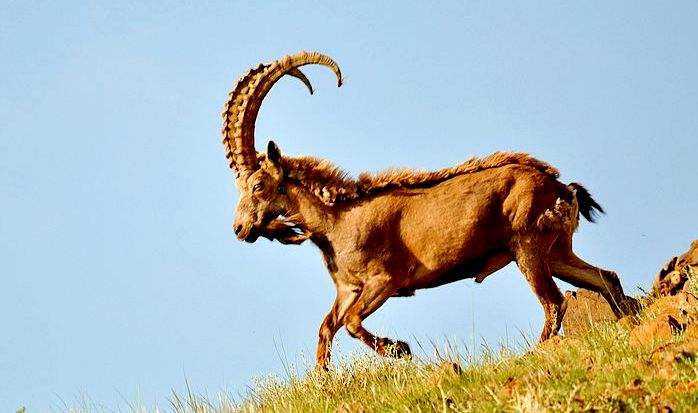Capra sibirica
IUCN
LCBasic Information
Scientific classification
- name:Capra sibirica
- Scientific Name:Capra sibirica,Siberian Ibex,Íbice asiático,Asiatischer Steinbock, Sibirischer Steinbock,Yangir Yamaa,Siberian ibex, Asian antelope, red sheep, hanging sheep, Himalayan goat, Asiatic wild goat
- Outline:Ungulata
- Family:Artiodactyla Ruminantia Bovidae Caprinae Capra
Vital signs
- length:115-170cm
- Weight:40-60, up to 120kg
- lifetime:12-18years
Feature
The goat with the longest horns in the world
Distribution and Habitat
Distributed in Afghanistan, China (Gansu, Xinjiang), India (Himachal Pradesh, Jammu - Kashmir), Kazakhstan, Kyrgyzstan, Mongolia, Pakistan, Russian Federation, Tajikistan, Uzbekistan.
In China, it is found in Xinjiang, northwest Tibet, Qinghai, northern Gansu and western Inner Mongolia.
It inhabits bare plateau rocks and rocky mountainsides at an altitude of 3500-6000 meters. It does not migrate to very low places in winter. It is one of the mammals with the highest habitat. However, in 2007, in the Chagan Mountain area in the eastern Altai Mountains of Xinjiang, China, it was found that many northern goats migrated to winter pastures at an altitude of more than 1,000 meters. In summer, it inhabits alpine meadows and bare rock areas, and in winter and spring, it migrates to areas with lower altitudes.
Appearance
The body length is 115-170 cm, the shoulder height is about 100 cm, and the weight is about 40-60 kg. But the largest weight can reach 120 kg. There are whiskers on the chin, which are longer in males and shorter in females. The tail is 10-20 cm long, and the tip of the tail is brown-black. The limbs are slightly shorter, appearing relatively sturdy, and the hooves are narrow.
The female is smaller, usually only one-third of the male. The top of the head is convex, the forehead is flat, the eyes are medium-sized, and the ears are short. The male has long whiskers under the chin, which are about 15 cm long, while the female has shorter whiskers. The limbs are slightly shorter, appearing relatively sturdy, and the hooves are narrow. The tail is longer. The fur color changes with the seasons. In summer, the back is brown-yellow, the sides are light brown, and the belly is white. The male has a black vertical stripe from the occipital part of the head along the spine to the base of the
Details
The Siberian Ibex, with four subspecies, is a typical wild goat.

Siberian Ibex is active at dawn and dusk and likes to move in groups. They are very good at climbing and jumping. Their hooves are very solid, with flexible heel joints and pliers-like toes, which enable them to run freely among the steep rocks. They rest on bare rocks during the day, and go to lower alpine meadows to find food and drink water in the morning and evening. They like to move in groups, usually 4-10, but there are also larger groups of dozens or even hundreds of them, led by strong males. They are very vigilant. When foraging, they will leave 2-3 females to stand guard, standing on a boulder not far from the group, watching the surrounding movements. Once they find something unusual, the group will immediately climb up the cliffs calmly, often leaving the snow leopard, known as a "mountain climbing expert", helpless.
The enemies of the ibex are mainly fierce carnivores, such as lynx, wolf, jackal and snow leopard. Especially snow leopards, they are the largest carnivores that are best at climbing. Of course, snow leopards mainly rely on sneak attacks to hunt ibex. If they attack head-on, they are no match for ibex in terms of running speed. Therefore, in order to avoid enemies, ibex only forage in dangerous places: with snow-covered mountain tops or glaciers on their backs, and bottomless abysses on both sides, leaving snow leopards no way to attack.
In addition to the best size in the goat family, the most prominent feature of ibex is its extremely exaggerated horns. Generally, the length of the horns of male Siberian ibex is slightly less than its body length, which can reach one meter. So far, the highest record of Siberian ibex horns has even reached 1.47 meters, which is longer than Xiao Si's height.
Among animals with long horns, the male ibex fights for mates most fiercely: "rivals" are extremely jealous of each other, lift their two front hooves and hang them in front of their chests, tilt their heads, and hit each other with their horns. The horns of both sides are deadlocked, and it is said that the force can reach 4 tons. The edges on the horns can prevent sliding and avoid accidentally injuring the opponent.
ibex usually estrus and mate from the end of November to the beginning of December. Males hit each other with their long horns until one side is exhausted and retreats and flees. The winner does not chase. Males often lower their heads and stretch their necks when chasing females. The gestation period of females is 170-180 days, and they give birth from May to July, with 1-2 babies per litter. The lactation period is 2 months, and they reach sexual maturity at 1-2 years old. Tolerant to roughage and strong in disease resistance.
Over the years, the Aksu region of Xinjiang, located in the south of the Tianshan Mountains, has taken a variety of measures to protect wild northern goats, which has significantly improved the living environment of wild northern goats and significantly increased the population.
Listed in the "Red List of Endangered Species of the World Conservation Union" (IUCN) 2020 ver3.1-Near Threatened (NT).
Listed in the China Biodiversity Red List Level: Near Threatened (NT).
On February 5, 2021, the northern goat was adjusted from the national first-level protected wild animal to the national second-level.
It is now listed in the second level of the "List of National Key Protected Wildlife in China".
Protect wild animals and eliminate game.
Maintaining ecological balance is everyone's responsibility!








